by Dave Meaney

In the aftermath of the presidential election, quite a few experts cited the lack of economic opportunity for many as a primary factor that elevated Donald Trump to the presidency. These changes in economic opportunity did not occur months prior to the election, but they resulted from years of continual changes in the US economy.
For example, manufacturing represented more than 50% of the economic output and jobs after World War II; it now represents only 10% of the economy. Professional services — in finance, health, insurance, education, and similar industries — represented less than 5% of the economy in 1950, while it now captures almost 40% of the economy. Our country went from makers to providers. Many other workplace traditions have also changed; e.g., one often doesn’t work for the same employer for decades, nor do workers have confidence that they will remain in the career they start in their 20s. A physician could become a business owner and then (if we are lucky) a teacher. These changes are causing many of us to ask: What should we be teaching our students for this future?
First, let’s understand how economies can change. One theory in economics puts these job sector shifts as part of Kondriateff waves, which pass through the US economy in (roughly) 50- to 80-year cycles. These “K-waves” reach back to late 18th century and continue to the current day. The economist Joseph Schumpeter reasoned that these waves were triggered by technological revolutions; e.g., the invention of the steam engine and new steel production processes led to a K-wave from 1850 to 1900 that included the development of the railroad system, the settling of the American West, and the emergence of the American economy as a global force. Similarly, the widespread availability of consumer computer power and the invention of the Internet in the late 20th century created a K-wave that began in 1990 and is cresting now with the emergence of alternative media (e.g., cutting the digital cord with online media access), the Internet of Things, and the Big Data wave.
Where Engineers Fit In
As engineers, we are naturally attracted to the idea that technology starts the wave that affects everything else. But this belief raises a question: If technology triggers waves, then how can we predict where the next wave will start? And a second question follows: How do we organize and educate ourselves so that we make the most of these technologies so society can ride this wave effectively, rather than absorb the displacements these waves create? Well, we all know it is hard to predict the future. However, a recent report from the Brookings Institute helps us pinpoint areas of the economy that are most powerful in creating downstream economic output, whether it is additional jobs, more exports, or the forming of completely new industries. Given their potency, it is likely that new economic opportunities will emerge more frequently from this sector than any other.
 Rather than using the traditional categorization scheme that breaks up the economy into bins associated with worker output (e.g., we manufacture, provide financial services, trade energy goods, supply food), the Brookings report asked a slightly different question: Which parts of the economy provide the downstream spark for the rest of us? If we understood the origin of this spark, we would be much more informed about how to make strategic investments that will have broad economic trickle-down effects on the national economy. The answer? The most potent part of our economy consists of the industries that invest heavily in research and development and contain a high percentage of employees with STEM degrees. The Brookings report termed these advanced industries. And this part of the economy is indeed potent. It generates 2.7 additional downstream jobs for every job in this sector, far outpacing the highly publicized downstream impact of the manufacturing sector (1.7 downstream jobs per manufacturing job). Advanced industries contain 8% of the workforce but generate 19% of the national GDP, and advanced industries span everything from communications, defense, and security to health, medicine, and the environment.
Rather than using the traditional categorization scheme that breaks up the economy into bins associated with worker output (e.g., we manufacture, provide financial services, trade energy goods, supply food), the Brookings report asked a slightly different question: Which parts of the economy provide the downstream spark for the rest of us? If we understood the origin of this spark, we would be much more informed about how to make strategic investments that will have broad economic trickle-down effects on the national economy. The answer? The most potent part of our economy consists of the industries that invest heavily in research and development and contain a high percentage of employees with STEM degrees. The Brookings report termed these advanced industries. And this part of the economy is indeed potent. It generates 2.7 additional downstream jobs for every job in this sector, far outpacing the highly publicized downstream impact of the manufacturing sector (1.7 downstream jobs per manufacturing job). Advanced industries contain 8% of the workforce but generate 19% of the national GDP, and advanced industries span everything from communications, defense, and security to health, medicine, and the environment.
Creating Economic Opportunity Waves
Knowing that this is the proverbial spark certainly places a premium on educating scientists and engineers and placing them in these advanced industries. Some of them could become the next Elon Musk, a Penn alum (SAS ’97) whose vision will eventually electrify the entire fleet of motor vehicles in the US. Others could follow in the footsteps of Carl June, MD, a Penn faculty member who invented a radically new form of cancer immunotherapy that may be the biggest change in cancer treatment in several decades. But what can colleges and universities teach students today to make them thrive in the epicenters of these advanced industries? How can we teach so that our students are ahead of the curve and, in some cases, creating these curves?
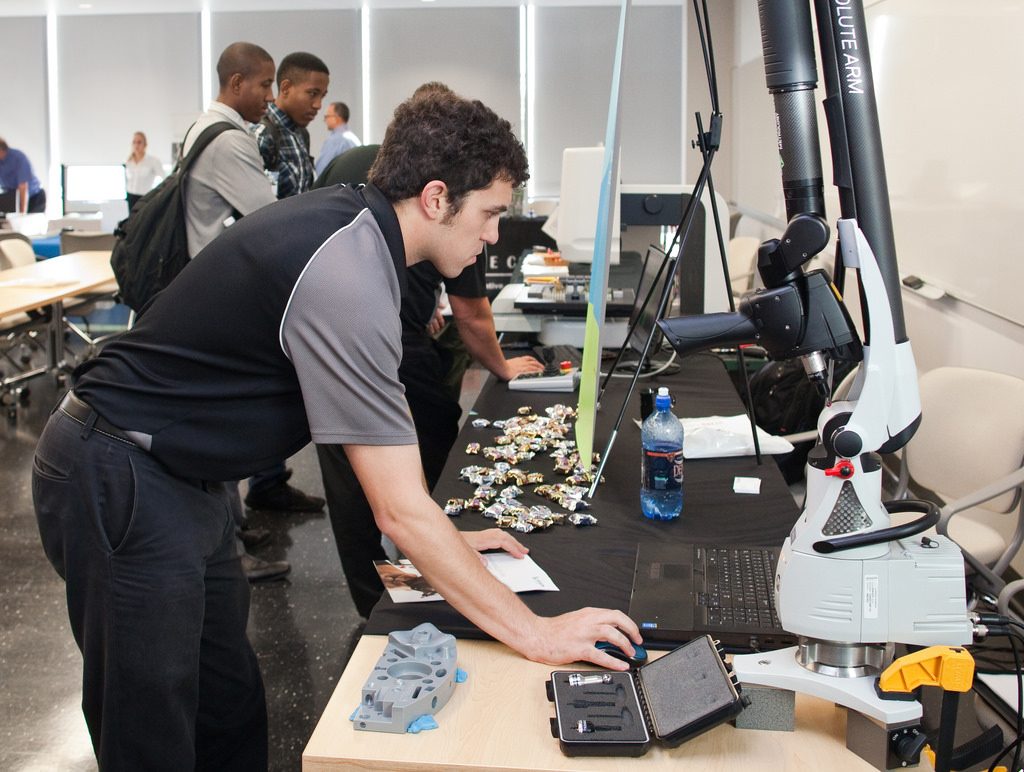
We are constantly discussing the content of undergraduate and graduate education here at Penn. In these conversations, it is often easy to fall into the trap of saying “Well, I can’t imagine a degree in X not having a course in Y” or “If I had to learn X, then my students should learn X too.” I think we should step away from specific courses and distribution sequences for a moment and think about the core principles in an engineering education that will allow our graduates to successfully navigate any economic wave that falls across all of us. In the most successful form, we would educate people that successfully create waves to benefit everyone. I suggest focusing on three core principles in an undergraduate’s engineering education toward achieving this goal.
- Introduce the uncertainty of research to counterbalance the certainty of formal didactic instruction. For engineering, teaching the fundamentals makes the world a safer place, whether we are teaching safety factors, repeatability, or design standards. But the advanced industries are at the bleeding edge of uncovering knowledge not in textbooks. And this new knowledge eventually creates something useful and interesting. Yet there is always a major transition for students when they realize that technological advances never come from a script in a textbook. Many will ask, “How can I learn anything that isn’t known?” Historically, we would use undergraduate education to teach what is known, and graduate education to answer the unknown. But if creating new ideas in advanced industries requires one to determine some of the unknowns, we shouldn’t restrict research experiences to just graduate education anymore.
Research forces one to learn the inexact science of breaking down a complex problem into more manageable parts, finding out which of these parts is most critical in solving the problem, and the finding a solution. Research uses failure as a mechanism to learn, and teaches persistence and patience. These are good things to learn if you want to be in industries that are searching for the Next Big Idea. In many ways, research experiences resemble learning a foreign language — the first language (research experience) is a real bear, but they get easier as you learn more of them (additional experiences). Jumping across different fields would parallel the learning of more than one foreign language and would be a good primer for a career in the advanced industries. If more of us became comfortable with uncertainty and failure, we would accelerate the creation and filtering of new ideas and products, in turn creating more opportunities for everyone in the economy.
- Teach invention, as it will continue to drive economic development. Over a decade ago, the American university system was recognized for its almost unique ability to educate students who would thrive as innovators over their careers. American higher education was sought after by students around the world, and world universities started to tweak their own models of education, inspired by the US success story. Much of what was written about the ‘secret sauce’ for American higher education was the magical ingredient of innovation that existed on college campuses in the US. However, we are overlooking the one critical ingredient upstream of innovation that makes the innovation engine go: inventing new ideas. So much activity surrounding innovation involves how to package ideas for marketplace needs or how to use marketplace needs to filter through existing technologies to create new products.
Our science and engineering infrastructure is driven by inventing technologies and algorithms that appear years to decades later in innovative products. And we are sorely overlooking how to best educate to invent, e.g., the classroom environment that forms the best ideas, or the best methods to teach the abstraction of several seemingly unrelated problems into a common group of invention challenges that will serve hundreds of innovations. Just as philosophy class in college can shape people’s views of morality for the rest of their lives, the practical experience of conceiving and executing a new idea for a market can leave a lifelong impression on a college student for seeing and creating opportunity in the world. Many students graduate nowadays with a much better idea about how to take ideas and commercialize them into products. Adding the teaching of invention will replenish the ideas that feed the future of these innovation pipelines.
- Include the economists, artists, and philosophers. Jason Silva has a wonderful quote about engineering: “The scientist and engineers who are building the future need the poets to make sense of it.” I couldn’t agree more. Artists and philosophers have an interesting reflection role in society, whether it is to challenge one’s perception of the ordinary or to make the ordinary unusual (artist) or to provide a more holistic view of a human’s purpose (philosopher). Likewise, economists can explain how technology can drive development locally and globally and the subsequent changes expected in the workforce. In other words, they all provide different optics on the same idea.
Engineering may enjoy a sterling reputation as creating a world that others do not see, but we are sometimes too enamored with this vision to ask a very simple question: If we can do it, should we do it? Technologists can cite several inventions in the past as drivers of economic change that pushed society forward (see K-waves, above) and never backward. The mechanization of the agriculture industry coincided with the emergence of manufacturing and heavy industries in the US and elsewhere in the 19th century, and this advanced the world. People moved from working on farms to working in factories, and the urbanization movement swept across the country. In a similar manner, artificial intelligence could cause a similar shift in the services sector today and create a supply of highly educated people to tackle the world’s next big problem. For this reason, they can help engineers understand the impact of their ideas even before they are implemented.
Creating new technologies without a thoughtful mulling about how they could really change the world seems irresponsible to me, given how some of these technologies could completely change large parts of the economic landscape quickly. And it could lead to other societal crises — e.g., do we really want to interrupt nature’s evolutionary clock without considering the impact of editing our own genome? Similar questions exist when we start to understand how our minds work and the principles by which we can (and should) study and influence the human traits of identity, reasoning, and self. One of our faculty recently wrote about the ethical constructs by which we should view these advances in understanding how we think, and how they can influence the science of mind control. Broadly speaking, initiating these conversations in advance will help engineers realize that these technologies should not be created in a vacuum, and they must be developed in parallel with conversations about the impact of their use.
A Mirror, Not a Trigger
All of this brings us back to the beginning. The election wasn’t the trigger but the mirror, and we must answer the call to think about engineering education to create future economic opportunity instead of passively watching it happen. We now know that advanced industries are the most powerful part of our economy for generating downstream economic output. We are fortunate that engineers are a central part of these industries. And we now know the dramatic changes in the demographics of opportunity among the electorate that occurred in the past two decades. By re-emphasizing core principles to impress upon our engineering students, we can be part of a future that focuses more on opportunities for the society rather than the individual. And we can use this new mindset to tackle some of the most pressing problems we see in front of us (e.g., affordable health care, energy, climate change) and those problems that we don’t see yet.

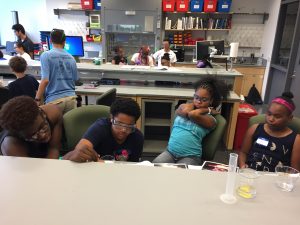 Each day of the week, from 9:15 a.m. to 5:00 p.m., the group of teens attended presentations, conducted experiments, and competed against one another in activities designed to have them apply the principles they learned about. Each day was dedicated to different topics: materials science on Monday; biology on Tuesday; chemistry and earth science on Wednesday; physics and computer science on Thursday; and a wrap-up day on Friday. In addition, over the course of the week, the students were scored for their activities, with a winner announced at the end of the week.
Each day of the week, from 9:15 a.m. to 5:00 p.m., the group of teens attended presentations, conducted experiments, and competed against one another in activities designed to have them apply the principles they learned about. Each day was dedicated to different topics: materials science on Monday; biology on Tuesday; chemistry and earth science on Wednesday; physics and computer science on Thursday; and a wrap-up day on Friday. In addition, over the course of the week, the students were scored for their activities, with a winner announced at the end of the week.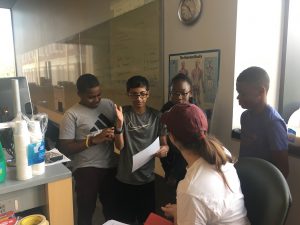 Here at Penn, the codirectors of the chapter are Jacqueline Valeri, a senior bioengineering major, and Monica Shen, a senior biology major. Asked about InnoWorks this year, Jackie said, “The InnoWorks program is a great camp to be involved with because the hands-on, interactive engagement really gets our students excited about science. We try to do really minimal lecturing time and maximize the opportunity for the students to actually do experiments, demonstrations, and design challenges. As codirector of this year’s program, it was really awesome to see what a great group of students we had this year and how they flourished throughout the week. This is my third year participating in Penn’s InnoWorks chapter and it has been one of the most rewarding, fun experiences that I’ve had at Penn!”
Here at Penn, the codirectors of the chapter are Jacqueline Valeri, a senior bioengineering major, and Monica Shen, a senior biology major. Asked about InnoWorks this year, Jackie said, “The InnoWorks program is a great camp to be involved with because the hands-on, interactive engagement really gets our students excited about science. We try to do really minimal lecturing time and maximize the opportunity for the students to actually do experiments, demonstrations, and design challenges. As codirector of this year’s program, it was really awesome to see what a great group of students we had this year and how they flourished throughout the week. This is my third year participating in Penn’s InnoWorks chapter and it has been one of the most rewarding, fun experiences that I’ve had at Penn!”




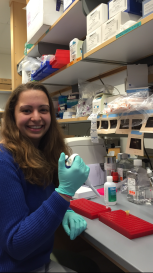
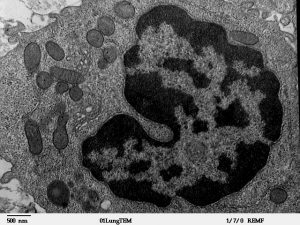
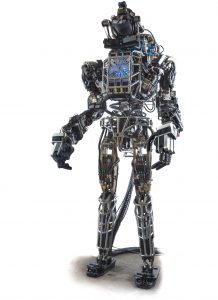
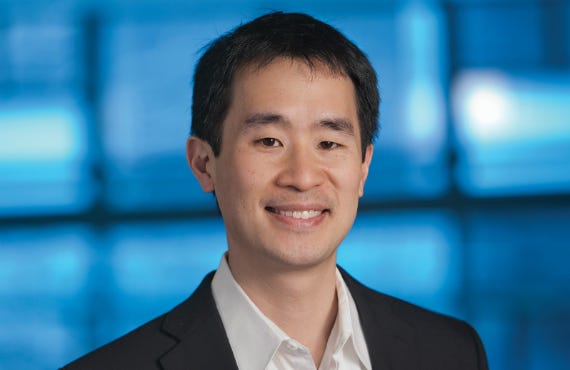



 Rather than using the traditional categorization scheme that breaks up the economy into bins associated with worker output (e.g., we manufacture, provide financial services, trade energy goods, supply food), the Brookings report asked a slightly different question: Which parts of the economy provide the downstream spark for the rest of us? If we understood the origin of this spark, we would be much more informed about how to make strategic investments that will have broad economic trickle-down effects on the national economy. The answer? The most potent part of our economy consists of the industries that invest heavily in research and development and contain a high percentage of employees with STEM degrees. The Brookings report termed these advanced industries. And this part of the economy is indeed potent. It generates 2.7 additional downstream jobs for every job in this sector, far outpacing the highly publicized downstream impact of the manufacturing sector (1.7 downstream jobs per manufacturing job). Advanced industries contain 8% of the workforce but generate 19% of the national GDP, and advanced industries span everything from communications, defense, and security to health, medicine, and the environment.
Rather than using the traditional categorization scheme that breaks up the economy into bins associated with worker output (e.g., we manufacture, provide financial services, trade energy goods, supply food), the Brookings report asked a slightly different question: Which parts of the economy provide the downstream spark for the rest of us? If we understood the origin of this spark, we would be much more informed about how to make strategic investments that will have broad economic trickle-down effects on the national economy. The answer? The most potent part of our economy consists of the industries that invest heavily in research and development and contain a high percentage of employees with STEM degrees. The Brookings report termed these advanced industries. And this part of the economy is indeed potent. It generates 2.7 additional downstream jobs for every job in this sector, far outpacing the highly publicized downstream impact of the manufacturing sector (1.7 downstream jobs per manufacturing job). Advanced industries contain 8% of the workforce but generate 19% of the national GDP, and advanced industries span everything from communications, defense, and security to health, medicine, and the environment.